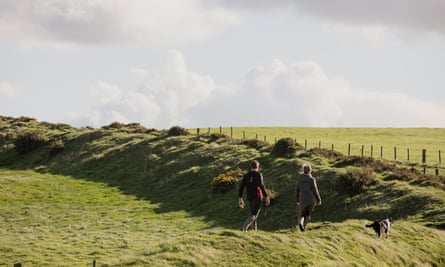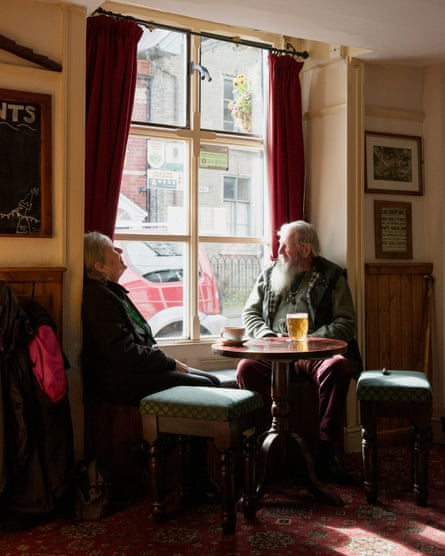The brief is simple. A two-day hike with a railway station at either end and a pub with rooms in the middle. No need to carry much, just a change of clothes, some lunch and water. I don’t want a circuit; I want a straight yomp across magnificent countryside with an evening in front of a log fire and a shiny array of real ale pumps.
I am under strict instructions from my partner Sophie not to be too ambitious. “We want the perfect weekend walk,” she says, “not an SAS survival course.”
I hide my notes: 1,500 metres of ascent is not going to happen.
“Maximum 12 miles a day,” she says. “Small hills and lovely weather.”
Finding the right location proves a challenge. Many of Britain’s rural railway lines have an unfortunate lack of stations (the UK once had about 9,000, but there is barely a third of that number left). The York to Scarborough line is typical: there are now only two intermediate stations in all its glorious 42 miles, down from a peak of 17.
But if railway stations have been badly hit, pubs have fared even worse. Figures for the third quarter of 2022 show UK closures running at 50 a month, part of a long-term decline, despite plenty of evidence that communities with a pub tend to prosper, economically and socially. Our walk then, if I can find it, might play a tiny part in supporting some vital rural institutions.
In the end I settle on a line that has kept its stations, and even a few “request stops”. The Heart of Wales line runs 121 miles from Shrewsbury to Swansea, with an impressive 32 jumping-off points in between. How the route has survived all the attempts to close it is a tribute to local determination – and perhaps the fact that it passes through several marginal parliamentary constituencies. There is even a footpath that loops in and out of touch with the line, enabling a whole host of possible weekend trips.
I decide to stick to the eastern end of the route, however, making the trip practical as a weekender from many major British cities.

Having embarked at Shrewsbury, we leave the train at Craven Arms, a good starting point as it lies on the Shropshire Way. This 200-mile figure-of-eight trail has Shrewsbury at its centre, and we’re on the southern loop. We head west out of town into steady rain, following the distinctive “buzzard” waymarkers across fields, then up into Withins Wood, where there’s an iron age hill fort.
For a few minutes the rain stops and there’s a sudden deluge of sunshine that raises thick mysterious mists among the trees. I brace myself. This is the kind of moment when the dreaded term “Tolkienesque” can leap out, but fortunately the rain returns, saving us that embarrassment.
Soon we spot the ghostly outline of Clun Castle through the clouds. The little town of Clun has punched above its weight for centuries, being both a river crossing and an overnight stop for Welsh drovers heading for the bright lights of Birmingham and London.
In the not-too-distant-past, Clun had 14 pubs. Now there are two, but that is still two more than most British settlements of this size (about 700 people). In ancient times this was the land of Eadric the Wild, who rebelled against William the Conqueror and reportedly married a supernatural enchantress whom he met in the nearby woods, presumably during a Tolkeinesque bout of mistiness.
Not that any of this impressed AE Housman, who declared Clun one of “the quietest places under the sun”. There’s no disgrace in that, we decide, wandering along the main street, meeting no one except a happy soul who helpfully shows us to the pub, pointing out the town’s astonishingly rich collection of doorknockers.
We arrive, a bit bedraggled, at the White Horse Inn, a welcoming and friendly spot for our stopover.
Next morning the rain has stopped and we head down across the 13th-century packhorse bridge and up to St George’s church, a huge edifice for a small town, with a fascinating graveyard. The playwright John Osborne is buried here next to his fifth wife, Helen (who was the Observer’s arts critic). Retracing our steps, we head for the castle. There’s a frill of ruined stonework on a mound and some earthworks out in the fields, relics of its last military engagement – when Owain Glyndŵr besieged it in the early 1400s. Since then not a lot seems to have happened, although I imagine it gets busy during the Green Man festival every August.

Back on the Shropshire Way again, we cross fields and start to rise up a long beautiful ridge towards the Welsh hills. The grassland is spangled with the brilliant yellows and crimsons of waxcap mushrooms and the hedgerow trees become increasingly gnarled and windswept. This is magnificent upland walking and it feels like we are treading back a few centuries, not least because we are entering some very dark clouds. “I asked for small hills and good weather,” says Sophie. “But I’m not complaining. I love it.”
At the high point we meet Offa’s Dyke and turn south along that footpath, following this classic route across high rolling countryside as the weather deteriorates into a wild storm. Sadly we don’t see much of the view. On every hawthorn berry shivers a pearl of rain and the sheep stand staring at us in sodden disbelief.
after newsletter promotion
I reckon Offa’s Dyke path is one of the finest in Britain and this section one of the best, despite occasional lapses in visibility. Barns have been built on it, access tracks bulldozed through, and septic tanks inserted, but there are places where you can still appreciate the magical madness of the eighth-century Mercian king’s folly, if that’s what it was. No one really knows why it was built. Through ragged holes in the clouds we see it ahead, clambering up the hillsides. In places the ramparts rise eight metres from the ditch below.
We roll into Knighton as darkness falls, just in time to jump on the train back to Shrewsbury. I am a definite convert to weekend pub walking between stations: two good days out with dinner plus pints in between, and almost no luggage. Perfect, even without lovely weather.
Google map of the route
Allow Google content?
This article includes content provided by Google. We ask for your permission before anything is loaded, as they may be using cookies and other technologies. To view this content, click ‘Allow and continue’.
Start Craven Arms railway station
Distance 21 miles
Time 2 days walking of about five hours a day
Total ascent 3,400 feet
Difficulty moderate
Take the train back from Knighton to Craven Arms or Shrewsbury
The pub

The White Horse bar is in the centre of Clun and a satisfyingly cosy place to break a two-day hike. We sit in a corner and wonder if we have fallen into an episode of The Archers. Everyone appears to know everyone. People buzz in and out. This is the kind of pub where someone enters and their favourite pint is poured before they ask for it, and is probably one of the (excellent) ales brewed on the premises. Osborne used to be among the regulars. Local legend has it that the original Angry Young Man’s home alcohol delivery was larger than the pub’s. (His former home, the Hurst, has become a writer’s retreat.)
The rooms
Rooms at the White Horse are plain and simple, but our bathroom features something very welcome to any walker, a hot bath. Food comes in ample portions and breakfast provides good fuel for the next day’s walking. If you prefer to be out in the surrounding countryside, head for YHA Clun Mill a short walk from the village.
The White Horse Inn has doubles from £90 B&B.







